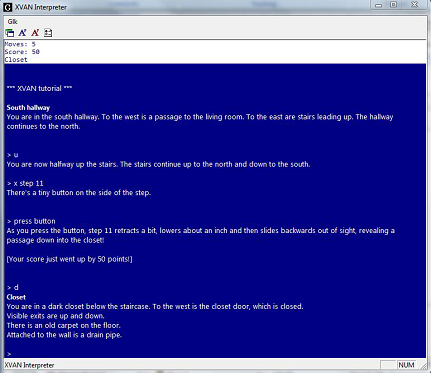-- everything is a location, an object or a timer --
XVAN tutorial - part 4
Part 4 – colors, fonts and status window
In this part of the tutorial we will look into text and background
colors, fonts and the use of the status window in the Glk version of the
interpreter.
Colors
By default the interpreter window shows white text on a black
background. XVAN has built in functions to change text and background
colors:
-
background(<color>) sets the background color
-
text(<color>) sets the text color.
Possible values for <color> are blue and black. Note that blue and black
must be defined as words in the vocabulary file.
Setting the background color to either blue or white automatically sets
the text color to white.
Setting the text color to either blue or white automatically sets the
background color to black.
For our sample story we want white text on a blue background, so we
change the player’s t_init trigger as follows:
o_player.t_init
t_init
background(blue) # blue background with white text
printcr(d_init)
printcr("")
entrance(owner(o_player))
Fonts (Glk interpreter)
XVAN has print functions that can print
boldface and
italic text:
-
printbold() and printcrbold()
-
printitalic() and printcritalic()
These functions work only in the Glk version of the interpreter. You do
not have to make separate game source files for Glk and non-Glk. The
non-Glk interpreter will handle these functions but will print normal
text.
In our tutorial story, we want the location names to be printed in
boldface. In the common t_entrance trigger and the various location
t_entrance triggers we change the text “printcr(d_shortdescr)” to
“printcrbold(d_shortdescr)”. We won’t copy it all here, you’ll find it
in the final story file part4-end.xvn.
Status window (Glk interpreter)
The Glk version of the interpreter has a three line status window on top
of the game window. Following functions are available to manipulate the
status window:
-
clearstatus() clears all text from the status window;
-
printstatus() prints text from current cursor position in status window;
-
printcrstatus() same as above but adds a carriage return;
-
setcursor() positions the cursor at the given position in the status window.
In the status window, we want to continuously display the player’s
location, number of moves and score. We create a trigger in the player
object:
t_status_window
clearstatus()
# print the number of moves
setcursor(0,0)
printstatus("Moves: [m_init]")
# print the score
setcursor(0,1)
printstatus("Score: [r_score]")
# print the location's name
setcursor(0,2)
if islit(l_location) then
printstatus(l_location.d_shortdescr)
else
printstatus("Darkness")
The non-Glk version of the interpreter will accept the commands but do
nothing.
We want to refresh the status window at the end of every move, so we
create the following timer:
m_status_window
init
0
step 0
direction up
interval 1
state
go
trigger_at 0
execute o_player.t_status_window
This is what the status window looks like (the white part above the blue
window).
This is the end of part 4. Everything we did is in the files
part4-end.xvn and
part4-end.lib (the last file is identical to part3-end.lib).
.